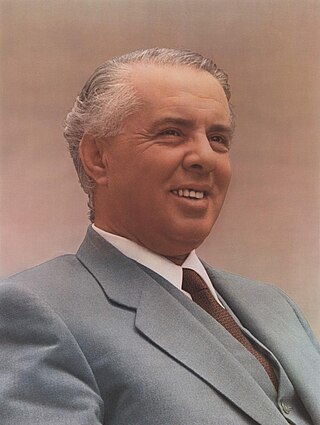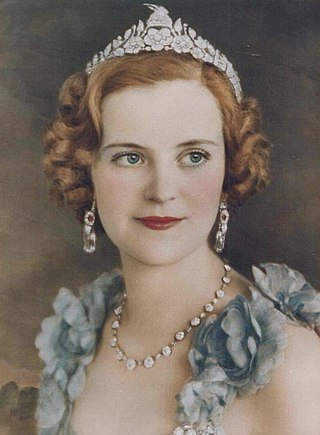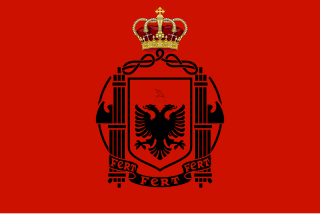
Enver Hoxha was an Albanian politician who was the ruler of Albania from 1944 until his death in 1985. He was the First Secretary of the Party of Labour of Albania from 1941 until his death, a member of its Politburo, chairman of the Democratic Front of Albania, and commander-in-chief of the Albanian People's Army. He was the twenty-second prime minister of Albania from 1944 to 1954 and at various times was both foreign minister and defence minister of the country.
During classical antiquity, Albania was home to several Illyrian tribes such as the Albanoi, Ardiaei, Bylliones, Dassaretii, Enchele, Labeatae, Taulantii, Parthini, Penestae, Amantes, and many others, but also Bryges and Epirote tribes, as well as several Greek colonies established on the Illyrian coast in cooperation with the local Illyrians, notably Epidamnos-Dyrrhachium and Apollonia.

Zog I was the leader of Albania from 1922 to 1939. At age 27, he first served as Albania's youngest ever Prime Minister (1922–1924), then as president (1925–1928), and finally as king (1928–1939).

Education in Albania for primary, secondary, and tertiary levels are mostly supported by the state. The academic year is much similar to that as in the United States, classes starts almost in September or October and end in June or July. Albanian is the language of instruction in all public schools. The education takes place in three stages such as the primary, secondary, and pre-university education. There are about 5000 schools throughout the nation.

In Albania, World War II began with its invasion by Italy in April 1939. Fascist Italy set up Albania as its protectorate or puppet state. The resistance was largely carried out by Communist groups against the Italian and then German occupation in Albania. At first independent, the Communist groups united in the beginning of 1942, which ultimately led to the successful liberation of the country in 1944.

Geraldine was Queen of the Albanians from her marriage to King Zog I on 27 April 1938 until King Zog was deposed on 7 April of the following year.

Leka, Crown Prince of Albania, was the only son of King Zog I and Queen Geraldine of Albania. He was called Crown Prince Skander at birth. Leka was the pretender to the Albanian throne and was referred to as King Leka I.
The Self-government of Mirdita was a short-lived self-government in northern Albania, led by Marka Gjoni and his followers. It existed between 17 July and 20 November 1921. Gjoni led his Roman Catholic Mirdita tribesmen in a rebellion against the Albanian regency and parliament established after the World War I. The Kingdom of Serbs, Croats and Slovenes, and its newly enthroned King Aleksandar Karadjordjevic, backed Gjoni based on its interest of having another separatist region within Albania, weakening the newly created Albanian state and sharpening the religious antagonism.

The Albanian Kingdom was the official name of Albania between 1928 and 1939. Albania was declared a monarchy by the Constituent Assembly, and President Ahmet Bej Zogu was declared King Zog I. The kingdom was supported by the fascist regime in Italy, and the two countries maintained close relations until Italy's sudden invasion of the country in 1939. Zog fled into exile and never saw his country again. The Communist Party of Labor of Albania gained control of the country toward the end of World War II, established a communist government, and formally deposed Zog.

The Albanian Republic was the official name of Albania as enshrined in the Constitution of 1925. Albania came into an alliance with the Kingdom of Italy after signing the Treaties of Tirana, which gave Italy a monopoly on shipping and trade concessions. Albania was declared a constitutional monarchy in 1928. Upon its inception, Italy demanded to be allies with the republic. This was done largely to increase Italy's influence in the Balkans, and to aid Italian and Albanian security in their territorial feuds with the Second Hellenic Republic and the Kingdom of Serbs, Croats, and Slovenes.

The Principality of Albania was a short-lived monarchy in Albania, headed by Wilhelm, Prince of Albania, that lasted from the Treaty of London of 1913 which ended the First Balkan War, through the invasions of Albania during World War I and the subsequent disputes over Albanian independence during the Paris Peace Conference of 1919, until 1925, when the monarchy was abolished and the Albanian Republic declared.

The Italian protectorate of Albania, also known as the Kingdom of Albania or Greater Albania, existed as a puppet state and protectorate of Fascist Italy. It was practically a union between Italy and Albania, officially led by Italian King Victor Emmanuel III and its government: Albania was led by Italian governors, after being militarily occupied by Italy, from 1939 until 1943. During this time, Albania ceased to exist as an independent country and became an autonomous part of the Italian Empire. Officials intended to make Albania part of a Greater Italy by assimilating Albanians as Italians and colonizing Albania with Italian settlers from the Italian Peninsula to transform it gradually into an Italian land.

The Italian invasion of Albania was a brief military campaign which was launched by the Kingdom of Italy against the Albanian Kingdom in 1939. The conflict was a result of the imperialistic policies of the Italian prime minister and dictator Benito Mussolini. Albania was rapidly overrun, its ruler King Zog I went into exile in neighboring Greece, and the country was made a part of the Italian Empire as a protectorate in personal union with the Italian Crown.

Albania–United States relations are diplomatic relations between the Republic of Albania and the United States of America. Relations were first established in 1911 following Albania's independence from the Ottoman Empire, ending in 1939 due to German and Italian occupation in the Second World War, and re-established in 1991 after the fall of communism in Albania and the dissolution of the Soviet Union.

Mirash Ivanaj was an Albanian politician, minister and school director, famous for his role in reforming education system in Albania.

The Ministry of Finances and Economy is a department of the Albanian Government, responsible for matters relating to economic policy, the central government budget, taxes, banking, security and insurance, international economic work, central, regional and local government.

The Queen Mother Pedagogical Institute, was a women's pedagogical high school, created in 1933 in Tirana, Albania.
Princess Senije Zogu (1903–1969) was an Albanian princess. She was the daughter of Xhemal Pasha Zogu and Sadije Toptani, his second wife, and was the third of six sisters of King Zog I of Albania. When her brother became monarch in 1928, she and her siblings were granted the status of Prince and Princess Zogu. She was the chairperson of the Albanian Red Cross and the women's organisation Gruaja Shiqiptare in 1928–1939.
Albania has been a secular state since its founding in 1912, despite various changes in political systems. During the 20th century after Independence (1912) the democratic, monarchic and later the totalitarian communist regimes followed a systematic secularisation of the nation and the national culture. The Albanian understanding of secularism has strong influences from the French laïcité.
















